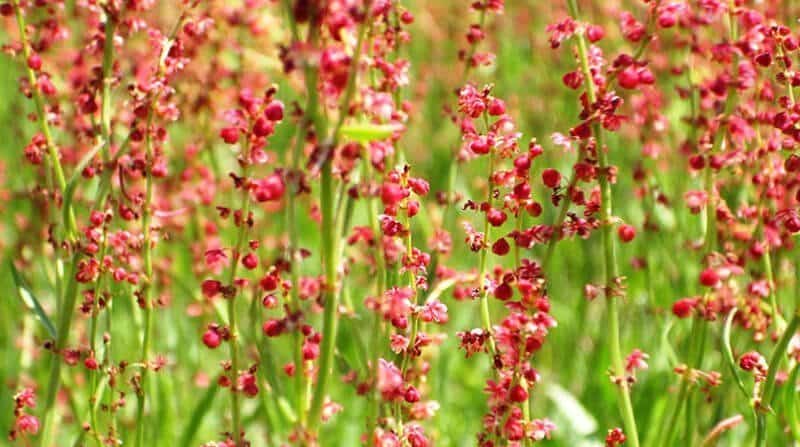There are two main types of Sorrel that is found in British lawns;
- Common Sorrel, and
- Sheeps Sorrel
They’re a relative of the dock and in grassland are loved by foraging animals. In lawns, however, they can cause major problems – especially Sheeps Sorrel.
That said, you can remove Sorrel with the right approach and a little patience.
Sorell in a Nutshell
As I have mentioned, there are two species of Sorrel that can cause a nuisance in your lawn.
Each one has slightly different characteristics.;
Sheeps Sorrel
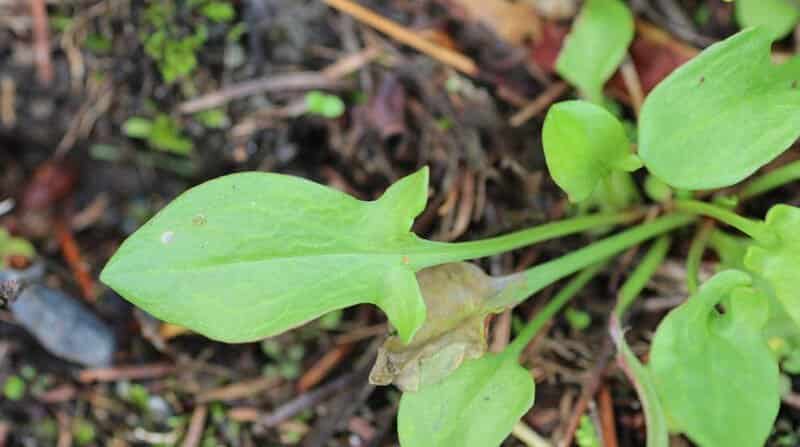
Sheep’s Sorrel or Rumex acetosella can be a major nuisance and is much more common in lawns than Common Sorrel, despite what the name suggests.
It has a rosette of arrow-shaped leaves with distinct lobes that turn up at the base. They grow from slender, wiry, creeping stems. This weed can cover a large area of turf.
The flowers, which are visible between May and August are very small. They start off green and turn red later in the season. They grow on stems to form ‘flower spikes’. That said, you won’t see the flowers if you mow the lawn regularly.
Common Sorrel
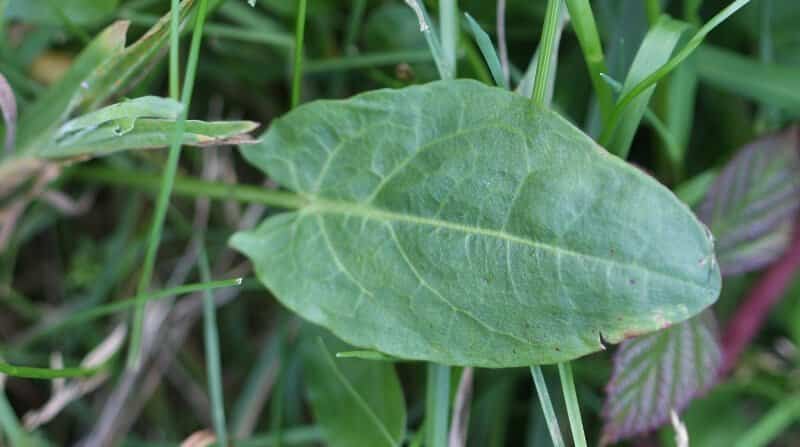
Common Sorrel or Rumex acetosa is much less common than Sheeps Sorrel.
Overall, it’s a bigger plant and the leaves are arrow-shaped but with lobes that point backwards, towards the stem.
The flowers are very much like Sheep Sorrel. They grow flower spikes which start off green and turn red as the plant gets older.
The flowering period is shorter too. It flowers between May and June. Again, if you cut the grass on a regular basis, you won’t see the plant flower.
A Perennial Weed
Sorrel is a perennial weed, meaning the same plant grows back year after year.
It mainly spreads via underground runners but it also produces lots of seed which can make it a bit of a nightmare.
Preferred Habitat
Sorrel will tolerate a wide variety of conditions but grows best in acidic soils.
How to Get Rid of Sorrel From Your Lawn
Some weeds like Daisies and White Clover are pretty simple to remove. Sorrel is not one of them!
Be prepared for a fight as it might take several attempts to get rid of it completely.
Remove it by Hand
Try removing weeds by hand as soon as you see them.
Sorrel spreads via underground runners called Rhyzomes to take your time to remove as many roots and runners as you can with a trowel or hand fork.
Taking your time to remove everything now will prevent it from growing back.
Try to Kill it with a Spot Spray Selective Weedkiller
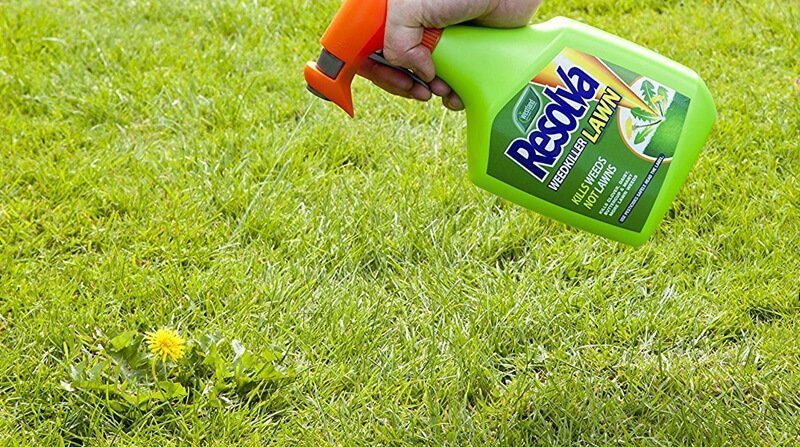
If it grows back after hand removal, or you want to try and kill it before removing it, try killing it with a selective weedkiller that kills weeds but not lawns.
Resolva Weedol Lawn Weed Killer is the best option in this case.
That said, it might take more than one application to kill it.
- Small spray bottle ideal for small areas
- Non-glyphosate formulation
Spray a Selective Weedkiller Concentrate Over the Whole Lawn
If you’ve got a lot of Sorrel in your lawn along with other weeds, spot spraying is useless.
Instead, use a selective weedkiller concentrate. Again, Weedol Lawn Weedkiller Concentrate is the best choice.
This is designed to be diluted in water and sprayed over the lawn with a knapsack sprayer or watering can.
Make sure you read the instructions can dilute it accurately though. If you make the solution too weak, it’ll have no chance of killing Sorrel. On the other hand, you might be tempted to make a strong dose but if you do this, you risk killing the grass.
- Apply through a sprayer or watering can
- Non-glyphosate formulation
Read: What’s the Best Weed Killer for Grass Lawns?
How to Prevent Sorrel From Growing in Your Lawn
The best way to prevent Sorrels from growing in your lawn is to make the conditions for grass growth the best you can. When the grass in your lawn is healthy and dense the less room there is for weed seeds to reach the soil and germinate.
Creating a really healthy, dense lawn with lots of lush green grass isn’t difficult. It just takes some basic knowledge and the commitment to apply it.
The following lawn care practices will prevent Sorrel or any other weed from growing in your lawn.
Mow the Lawn on a Regular Basis

Cutting the grass is the single, most important part of maintaining a healthy lawn. At the same time it is also the most overlooked aspect and as such, so many people do it wrong.
It’s vitally important that you cut the grass regularly. At least every 10 days between April and October. When growing conditions are at their best (usually in May and September) cut the grass every 7 days.
Here’s why…
Between March and October, grass grows co and if you let it, it will keep growing upwards. By cutting it regularly you stop it from growing upwards so it looks for other ways to grow.
As a result, it grows side shoots called runners which sprout new grass leaves. It’s these new runners and new grass leaves that create a lawn that is thick with grass.
Because the grass is so dense, weed seeds very rarely make it to the soil to germinate. Even if they do, the grass outcompetes them anyway.
However, if you cut the grass every 6 weeks when you can be bothered the grass will continue to grow upwards. It won’t need to grow sideways so it won’t ever be as thick as it could (or should) be.
There’s another issue with irregular grass cutting too.
As you cut the grass short you’re almost guaranteed cut too much off the leaf. The leaf not only stores food and water but also traps sun so the grass can keep producing food via photosynthesis.
When you cut too much off the leaf, you take away the grasses food and water supply. You also take away its ability to create more food because there is no leaf left to trap the sunlight.
This shocks the grass and often kills it, turning it brown and spiky. Weeds love areas where grass can’t grow.
So mow regularly!
Read: How to Mow the Lawn Like a Pro
Get Rid of Excess Thatch by Scarifying Your Lawn
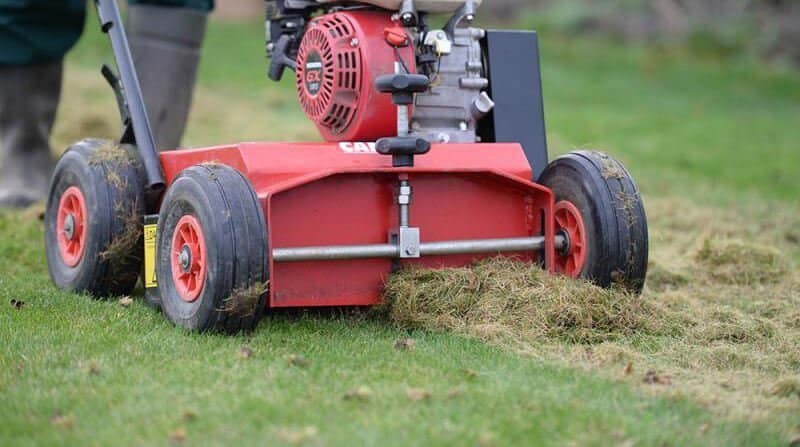
Lawn thatch is a fibrous layer lies just above the surface of the soil, in amongst the grass and roots. It’s made up of both living and dead organic material including grass clippings, roots and other material.
All lawns have thatch and a little bit of it is a good thing as it protects the crown of the grass plant from damage and disease.
However, too much of it can cause problems as it can prevent air, water and nutrients from reaching the soil.
Grass relies on these nutrients to grow, fight off disease and tolerate drought. Without them grass becomes weak and growth stunts, resulting in a patchy, threadbare lawn. This opens the door for weeds and moss to invade.
Scarification uses a machine to tear the excess thatch out of your lawn so air, water and nutrients can penetrate the soil, giving the grass what it needs to grow and stay healthy.
Be warned though, scarification is an invasive procedure that’ll leave your lawn looking pretty awful. But with the correct recovery procedure, it’ll recover and look better than ever.
Aerate the Soil to Relieve Compaction
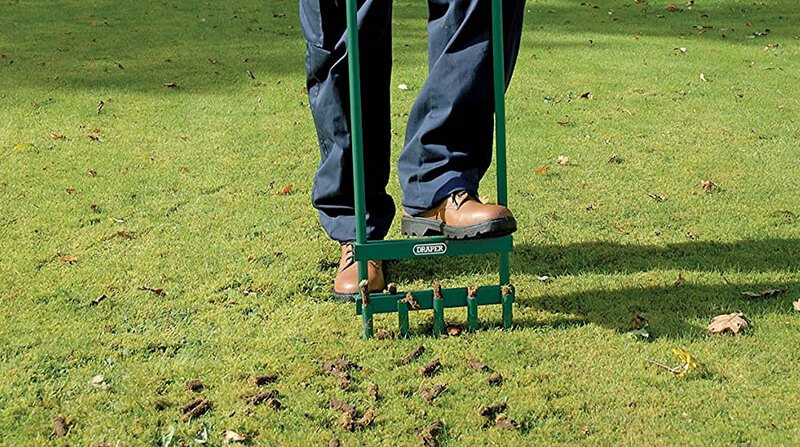
If you or your family use the lawn every day the soil underneath can become compacted.
When kids run and tumble on the grass or if you walk on a particular part regularly (around the washing line?) the soil particles under the grass get pushed together. This squeezes out air and water that grass relies on to grow and prevents any nutrients from being able to penetrate.
It also makes the ground hard so the root zone of the grass cant grow and establish itself.
Again, this results in weak, unhealthy grass that is unable to fight off disease and infestations of weeds and moss.
Aeration is the process of opening up the soil so air, water and nutrients can get to the root zone of the grass.
This is usually done by spiking the lawn (usually in the spring) or removing cores of turf by hollow-tining (usually in autumn).
It’s a very simple procedure and spiking is very easy to do. Hollow-tining can be hard work though.
Read: The ULTIMATE Guide to Lawn Aeration: Everything You Need to Know About Relieving Soil Compaction
Keep Your Lawn Topped Up With Fertiliser
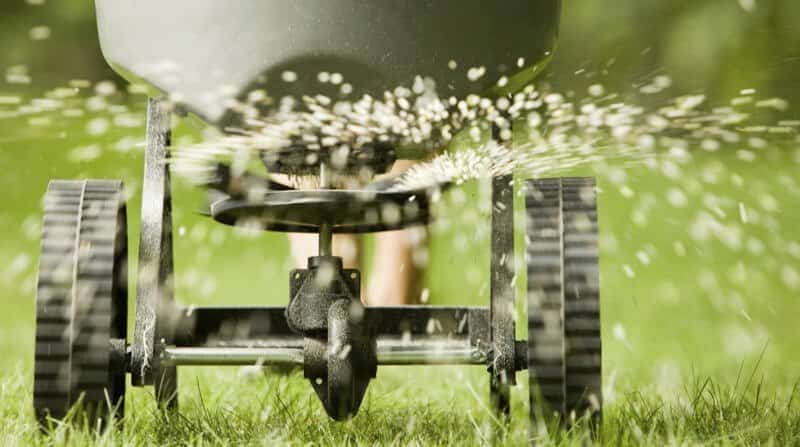
Grass grows best in soil that is rich in Nitrogen, Potassium and Phosphate.
If your soil is lacking in these nutrients, grass growth will be slow, your lawn will be patchy and the grass won’t be as healthy as it should be. This means it won’t be able to tolerate drought very well and weeds like Sorrel are able to take over. Sorrel loves soils that are low in Nitrogen so it’s important to keep it Nitrogen rich.
Even if you’re a reluctant gardener, just one application of a good quality, slow-release fertiliser a year will work wonders.
Read: What, Why, When and How to Fertilise Your Lawn
Also Read: Which is the Best Lawn Fertiliser? A Complete Buyers Guide
Wrapping Up
Sorrel can be a tough weed to get rid of so be prepared for a fight.
If you’ve only got one or two weeds then try removing them by hand. If you take your time to remove every last bit of it you’re golden.
Should it grow back, blast it with a weedkiller but chances are it’ll take more than one application.
And the best way to prevent it coming back, or even growing in the first place is with good lawn care practices.
